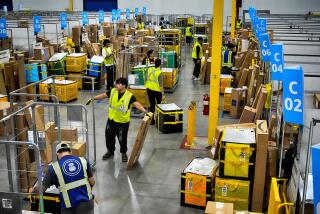Worker Productivity Gained 4.3% for 2000
WASHINGTON — The productivity of U.S. workers grew at a solid pace in the final quarter of 2000, capping the best year since 1983, but unit-labor costs climbed sharply, the government said Wednesday.
The productivity of nonfarm workers rose at an annual rate of 2.4% in the fourth quarter, the Labor Department said. Although that is considered a strong growth rate, it lagged the 3% gain in the third quarter.
For all of 2000, productivity surged 4.3%. Last year’s leap in productivity capped a five-year stretch in which productivity growth averaged a strong 2.8%, double the lackluster average growth rate of 1.4% in the two decades since 1973.
“It is truly extraordinary to get this kind of productivity growth this late in the expansion or just ahead of a recession,” said David Resler, chief economist at Nomura Securities International in New York.
“It is a sign the economy has moved to a higher level of productivity growth that justifies expectations of a higher long-run potential growth of 3.5 to 4%,” Resler said of the productivity figures, which measure the amount of goods and services workers produce per hour.
But in a piece of news that unsettled Wall Street, unit-labor costs shot up 4.1% in the October to December period, departing from the usual trend in which strong productivity usually holds down labor costs.
Analysts said the unit-labor costs jump might slightly lessen the odds that the Federal Reserve would act ahead of its March 20 meeting to cut interest rates. But economists suggested the higher labor costs posed a greater threat to corporate profits than of inflation.
“We did see a further pickup in wages and benefit pressures, including costs of health care, as the year came to a close, but the impact on inflation has been minimal at this point because companies lack the general ability to raise prices to cover rising labor costs,” said Lynn Reaser, chief economist at Banc of America Capital Management.
Economists attribute the gains in productivity to business investment in computers and other high-tech equipment. Some economists increasingly believe that the sizable gains represent a lasting structural change in the economy.
Meanwhile, a report from the Fed underlined the softening in the economy. The Fed said consumer installment credit rose by $3 billion, at a 2.4% annual rate, slowing sharply from a revised $13.9-billion jump in November when credit boomed ahead at an 11.1% rate.
The Fed said it was the smallest monthly credit rise since September 1999, when it increased by $1.78 billion.
The unit-labor costs data in some ways crystallized what has been troubling the stock market lately: worries about profit erosion as economic growth winds down but as corporate costs continue to rise.
But economists said that on the whole, the productivity report was a mixed one, with some clearly good news in the 2.4% fourth-quarter productivity gain.
Economists have widely expected productivity growth to decelerate now that the economy has cooled. Just how much it tapers off will be crucial to the outlook for inflation and corporate profits.
When worker productivity rises rapidly, companies can afford to give employees big pay raises without having to cut into profits or pass the costs along to consumers.
“Normally, when you get an economic slowdown you get into an environment where productivity growth can disappear quickly,” said Steve Ricchiuto, economist at ABN/Amro in New York. But he added that in the latest data productivity growth held up pretty well.
(BEGIN TEXT OF INFOBOX / INFOGRAPHIC)
Productivity
Percentage change from previous quarter at annual rate, seasonally adjusted:
*
4th quarter: 2.4%
Source: Labor Department
More to Read
Inside the business of entertainment
The Wide Shot brings you news, analysis and insights on everything from streaming wars to production — and what it all means for the future.
You may occasionally receive promotional content from the Los Angeles Times.








